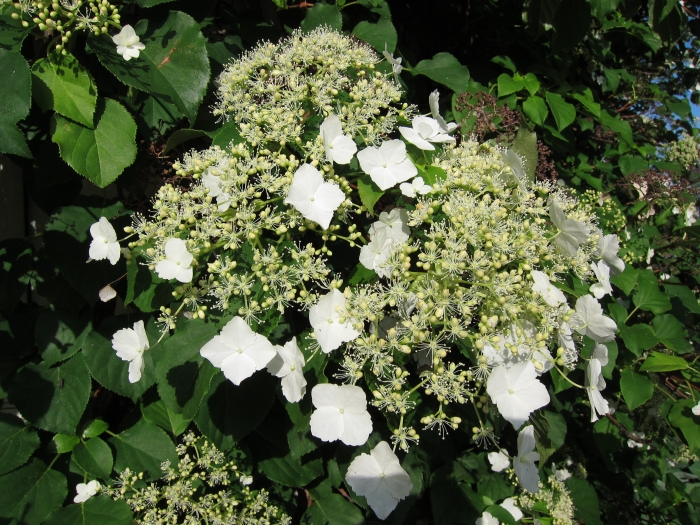Japanese Climbing Hydrangea
(Hydrangea anomala)
Japanese Climbing Hydrangea (Hydrangea anomala)
/
/

Kymi
CC BY-SA 3.0
Image By:
Kymi
Recorded By:
Copyright:
CC BY-SA 3.0
Copyright Notice:
Photo by: Kymi | License Type: CC BY-SA 3.0 | License URL: https://creativecommons.org/licenses/by-sa/3.0 | Uploader: Kymi | Publisher: Wikimedia Commons | Title: Köynnöshortensia_(Hydrangea_anomala_subsp._petiolaris).jpg | Notes: User created page with UploadWizard |

























Estimated Native Range
Summary
Hydrangea anomala, commonly known as Japanese Climbing Hydrangea, is a deciduous perennial vine that is native to woodlands and forest edges in the Himalayas, and East and Southeast Asia. It can reach up to 12 meters in height, climbing trees or rock faces with the aid of small aerial roots along the stems. The leaves are heart-shaped at the base, ovate, with a coarsely serrated margin and an acute apex. The vine is particularly noted for its mid-summer blooms, which consist of flat corymbs with peripheral sterile white flowers that are larger and showier than the numerous small, creamy-white fertile flowers in the center. The fruit is a dry urn-shaped capsule containing several small winged seeds. The ornamental value of Hydrangea anomala lies in its lush foliage and attractive lacecap flowers, making it a popular choice for adding vertical interest in shaded garden areas.
This vine is valued for its ability to thrive in shaded conditions, which makes it suitable for north-facing walls and areas under tree canopies. It requires medium amounts of water and can adapt to a range of soil drainage conditions. While it prefers moist, well-drained soils, it is relatively tolerant of different soil types. The subspecies H. anomala subsp. petiolaris is especially esteemed for its vigor and has earned the Royal Horticultural Society’s Award of Garden Merit. Gardeners should be aware that while generally disease-resistant, it can be susceptible to leaf spot and powdery mildew in humid conditions. It is also a slow starter, which may require patience in the first few years of growth.CC BY-SA 4.0
This vine is valued for its ability to thrive in shaded conditions, which makes it suitable for north-facing walls and areas under tree canopies. It requires medium amounts of water and can adapt to a range of soil drainage conditions. While it prefers moist, well-drained soils, it is relatively tolerant of different soil types. The subspecies H. anomala subsp. petiolaris is especially esteemed for its vigor and has earned the Royal Horticultural Society’s Award of Garden Merit. Gardeners should be aware that while generally disease-resistant, it can be susceptible to leaf spot and powdery mildew in humid conditions. It is also a slow starter, which may require patience in the first few years of growth.CC BY-SA 4.0
Plant Description
- Plant Type: Vine
- Height: 30-40 feet
- Width: 5-6 feet
- Growth Rate: Moderate
- Flower Color: White, Cream
- Flowering Season: Spring, Summer
- Leaf Retention: Deciduous
Growth Requirements
- Sun: Part Shade, Full Shade
- Water: Medium
- Drainage: Slow, Medium, Fast
Common Uses
Bank Stabilization, Bee Garden, Bird Garden, Butterfly Garden, Fragrant, Hummingbird Garden, Rabbit Resistant, Salt Tolerant, Showy Flowers, Street Planting
Natural Habitat
Woodlands and forest edges in East Asia
Other Names
Common Names: Climbing Hydrangea, Klätterhortensia, Guan Gai Xiu Qiu
Scientific Names: , Hydrangea anomala, Hydrangea anomala subsp. sericea, Hydrangea glaucophylla subsp. sericea,
GBIF Accepted Name: Hydrangea anomala D.Don